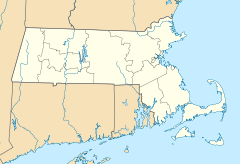- Cyclorama Building
-
Cyclorama Building
Location: Boston, Massachusetts Coordinates: 42°20′40″N 71°4′19″W / 42.34444°N 71.07194°WCoordinates: 42°20′40″N 71°4′19″W / 42.34444°N 71.07194°W Built: 1884 Architect: Cummings and Sears Architectural style: Classical Revival, Late Victorian, Other Governing body: Local NRHP Reference#: 73000318
[1]Added to NRHP: April 13, 1973 The Cyclorama Building is an 1884 building at 543-547 Tremont Street in Boston, Massachusetts that is operated by the Boston Center for the Arts.
Contents
History
The Classical Revival style Victorian building was commissioned by Charles F. Willoughby's Boston Cyclorama Company to house the Cyclorama of the Battle of Gettysburg, a 400-by-50 foot cyclorama painting of the Battle of Gettysburg. It was designed by Charles A. Cummings and Willard T. Sears. The central space is a 127'-diameter steel-trussed dome which, when it was built, was the largest dome in the country after the United States Capitol building.
In 1889, a new cyclorama painting Custer's Last Fight, was installed, but by 1890, the fashion for cycloramas had ended, and the new owner of the building, John Gardner (father-in-law of Isabella Stewart Gardner), converted it to a venue for popular entertainment, including a carousel, roller skating, boxing tournaments (including an 1894 fight of John L. Sullivan), horseback riding, bicycling, and so on.
By 1899, it had become an industrial space, used by the New England Electric Vehicle Company, the Tremont Garage, the Buick Automobile Agency, and Albert Champion Company. Albert Champion is said to have invented the spark plug here before he moved to Flint, Michigan.
When the Boston Flower Exchange bought the building in 1923, it added a new entrance and covered central dome with a skylight. The Flower Exchange moved out in 1970.
Boston Center for the Arts
The Boston Redevelopment Authority designated the Boston Center for the Arts as the developer for the Cyclorama and the surrounding buildings in 1970.
The Cyclorama was added to the National Register of Historic Places in 1973.
Bunker Hill Cyclorama
Another, competing cyclorama building was built two blocks from the first, and displayed a cyclorama of The Battle of Bunker Hill.[2]
References
- ^ "National Register Information System". National Register of Historic Places. National Park Service. 2008-04-15. http://nrhp.focus.nps.gov/natreg/docs/All_Data.html.
- ^ Illustrated Boston, the metropolis of New England, 1889, p. 118
External links
- The Cyclorama at the Boston Center for the Arts
- Boston Public Library. Cyclorama info, with images of 19th c. Battle of Gettysburg paintings by Paul Philippoteaux
U.S. National Register of Historic Places Topics Lists by states Alabama • Alaska • Arizona • Arkansas • California • Colorado • Connecticut • Delaware • Florida • Georgia • Hawaii • Idaho • Illinois • Indiana • Iowa • Kansas • Kentucky • Louisiana • Maine • Maryland • Massachusetts • Michigan • Minnesota • Mississippi • Missouri • Montana • Nebraska • Nevada • New Hampshire • New Jersey • New Mexico • New York • North Carolina • North Dakota • Ohio • Oklahoma • Oregon • Pennsylvania • Rhode Island • South Carolina • South Dakota • Tennessee • Texas • Utah • Vermont • Virginia • Washington • West Virginia • Wisconsin • WyomingLists by territories Lists by associated states Other  Category:National Register of Historic Places •
Category:National Register of Historic Places •  Portal:National Register of Historic Places
Portal:National Register of Historic PlacesThis article about a National Register of Historic Places listing in Suffolk County, Massachusetts is a stub. You can help Wikipedia by expanding it.



